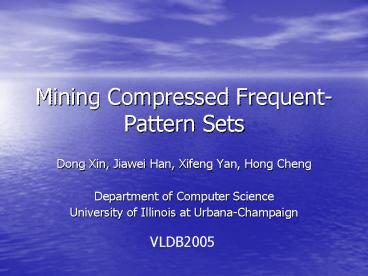Mining Compressed FrequentPattern Sets - PowerPoint PPT Presentation
1 / 22
Title:
Mining Compressed FrequentPattern Sets
Description:
To solve this problem, it's natural to explore how to 'compress' the patterns ... Our compressing framework. Clustering frequent ... Pattern Compressing Problem ... – PowerPoint PPT presentation
Number of Views:68
Avg rating:3.0/5.0
Title: Mining Compressed FrequentPattern Sets
1
Mining Compressed Frequent-Pattern Sets
- Dong Xin, Jiawei Han, Xifeng Yan, Hong Cheng
- Department of Computer Science
- University of Illinois at Urbana-Champaign
VLDB2005
2
- Introduction
- Problem statement
- Discovering Representative Patterns
- Performance study
- Conclusion
3
Introduction
- Frequent pattern mining
- High minimum support common sense patterns
- Low minimum support explosive number of results
- To solve this problem, its natural to explore
how to compress the patterns
4
Two major approaches
- Lossless compression
- Closed frequent patterns
- Lossy approximation
- Maximal frequent patterns
5
A Motivating Example
- A subset of frequent item-sets in accident
dataset - High-quality compression needs to consider both
expression and support
Expression of P1
Support of P1
6
A Motivating Example
- Closed frequent pattern
- Report P1,P2,P3,P4,P5
- Emphasize too much on support
- no compression
- Maximal frequent pattern
- Only report P3
- Only care about the expression
- Loss the information of support
- A desirable output P2,P3,P4
7
- Our compressing framework
- Clustering frequent patterns by pattern
similarity - Pick a representative pattern for each cluster
- Three problems
- How to measure the similarity of the patterns
- How to define quality guaranteed clusters where
there is a representative pattern best describing
the whole cluster - How to efficiently discover these clusters
8
Problem statement
- Distance measure Let P1 and P2 be two closed
patterns. The distance of P1 and P2 is defined
as - Ex Let T(P1)t1, t2, t3, t4, t5,
T(P2)t1, t2, t3, t4, t6, then
D(P1, P2)1-4/61/3
9
Clustering criterion
- A pattern P is d-covered by another pattern P if
P can be expressed by P and D(P, P)?d. - A set of patterns form a d-cluster if there
exists a representative pattern Pr such that for
each pattern P in the set, P is d-covered by Pr.
10
Pattern Compressing Problem
- Given a transaction database, a min_sup M and the
cluster quality measure d - The pattern compression problem is to find a set
of representative patterns R - For each frequent pattern P, there is a
representative pattern Pr?R which covers P - The value of R is minimized.
11
Discovering Representative Patterns
- RPglobal
- RPlocal
12
To collect the complete coverage information
- Input FP, M, d
- Output representative patterns
- Begin
- for each P?FP s.t. support(P)?M
- insert P into the set E
- for each Q?FP, s.t. Q covers P
- insert P into set(Q)
- while E!F
- find a RP that maximizes set(RP)
- for each Q?set(RP)
- remove Q from E and the remaining sets
- output RP
- End
To find the set of representative patterns
13
- RPglobal is expensive
- Assume all frequent patterns are mined
- Need to compute the pair-wise distance between
all frequent patterns - Need to find the globally best representative
pattern - RPlocal
- Find a locally good representative pattern
- Directly mine from raw data
- Do not compute the distance pair-wisely
14
RPlocal
- Algorithm
- Follow the depth-first search in pattern space
- Remember all previously discovered representative
patterns - For each pattern P
- Not covered yet
- Being Visited in the second time which traversal
back from its sons - Select a representative pattern using local
method (with P as new probe pattern)
15
Pattern P
Ps son
Visited patterns covering P
16
Efficient Implementation
- Non Closed Pattern
- Exist a super pattern with same support
- Closed_Index (N bits)
- Each bit remembers the consistency of an item
- Aggregate the closed_index with pattern
- Not closed if at least one out-pattern bit is set
(c,a) 111010
f does not belong to (c,a). Support of (c,a) is
same as support of (f,c,a). (c,a) is not closed
17
(No Transcript)
18
Performance study
- Comparing algorithms
- FPclose an efficient algorithm to generate all
closed itemsets, winner of FIMI workshop 2003 - RPglobal first use FPclose to generate closed
itemsets, then use global greedy method to find
representative patterns - RPlocal directly used local method to find
representative patterns from raw data
19
Performance Study
- Number of Representative Patterns
20
Performance Study
- Running Time
21
Performance Study
- Quality of Representative Patterns
22
Conclusion
- To approximate a collection of frequent patterns
- RPglobal
- works well on small collection of patterns
- RPlocal
- much more efficient
- Still quite good compression quality































